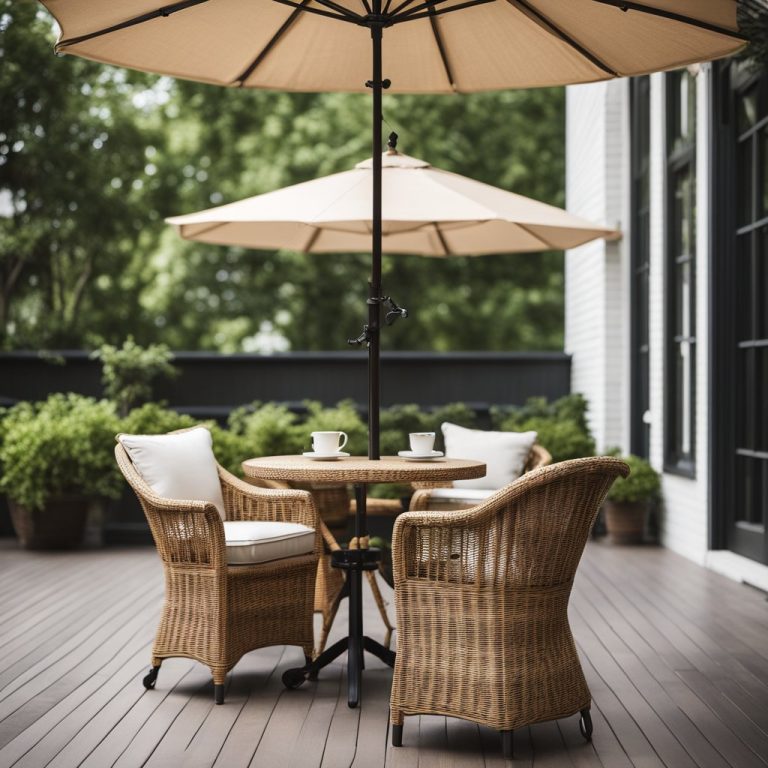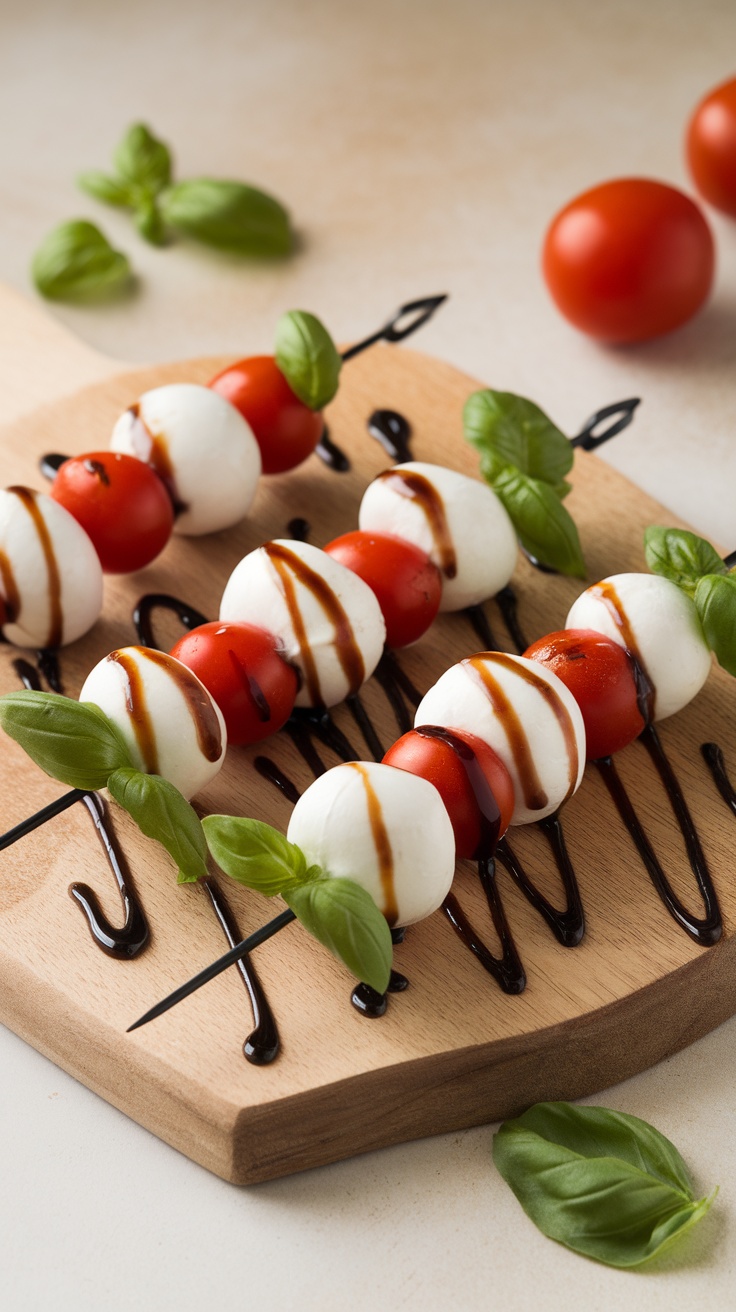Friendsgiving Games
The 11 Best Friendsgiving Games to Keep the Fun Going After Dinner
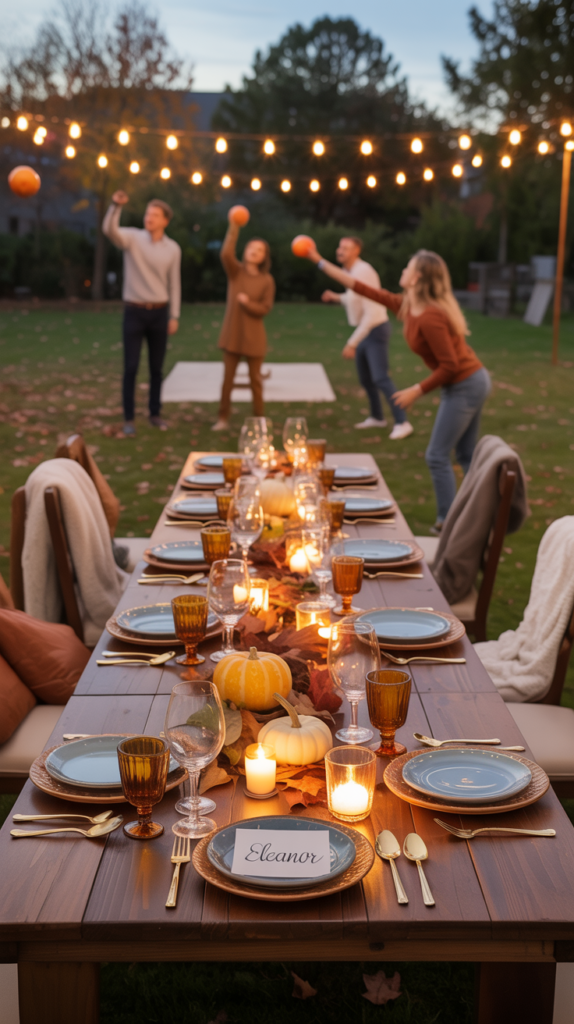
Friendsgiving brings everyone together around the table, but the best memories often happen beyond the meal. Laughter, movement, and playful competition turn a simple gathering into something unforgettable. Adding games to your celebration creates energy, connection, and moments that last long after the dishes are cleared.
This isn’t about kids’ party games—it’s about fun, creative activities that adults actually look forward to. Outdoor challenges, team competitions, and cozy group moments add variety and keep the night flowing. With the right mix, your Friendsgiving shifts from a dinner to an experience everyone talks about for years.
Turkey Feather Hunt
Turn a simple feather hunt into a festive game that gets everyone laughing and moving. Scatter bright paper feathers or metallic-painted ones around your yard or living room. The colors make the hunt feel cheerful and seasonal.
Hand out small baskets so everyone has a place to collect their finds. Add excitement by tucking a few feathers with stickers or notes that can be traded for small prizes. This keeps the game fun for kids and adults alike.
Keep the rules easy so no one feels left out. Set a timer, let everyone search, and then gather together to compare what was found. It’s a lighthearted way to burn a little energy before sitting down to dinner.
Pumpkin Bocce Ball

Pumpkin Bocce Ball brings a fall twist to the classic lawn game. Instead of heavy bocce balls, you roll mini pumpkins across the yard. The goal stays the same—get your pumpkin as close as possible to the target pumpkin without passing it.
The best part comes from the pumpkins themselves. Their odd shapes and uneven sides make every roll unpredictable. A pumpkin might wobble, curve off course, or stop short, which keeps everyone laughing and guessing what will happen next.
This game works well for an outdoor Friendsgiving gathering. It gives guests a chance to move around, enjoy the crisp air, and compete in a lighthearted way. Pair it with cocktails or warm drinks, and the game feels even more festive.
Pumpkin Bocce Ball is simple to set up and doesn’t require special equipment. All you need are a few small pumpkins and a bigger one to serve as the target. Once the rolling starts, the game quickly becomes a highlight of the evening.
Gratitude Ring Toss
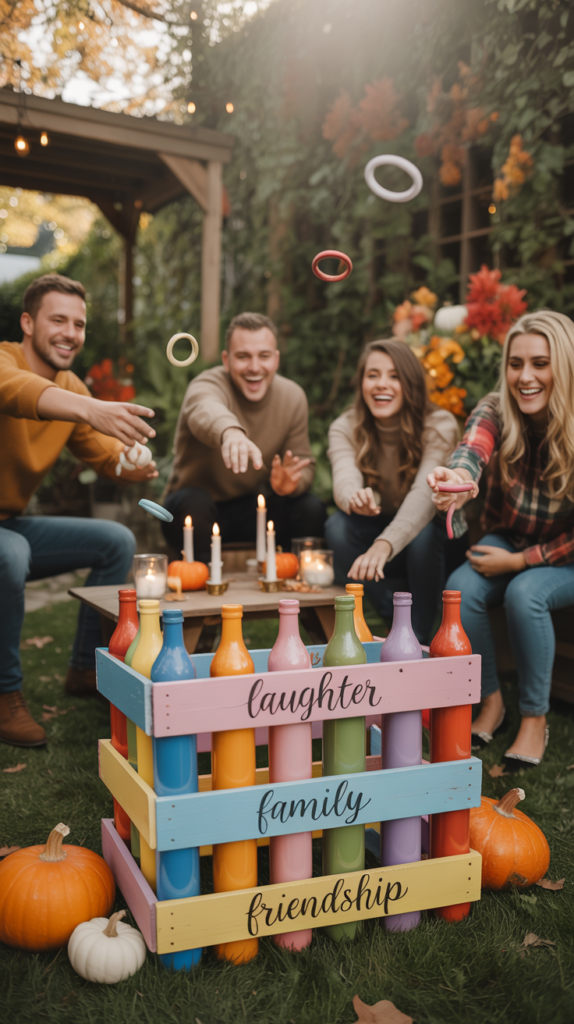
Set up a simple ring toss game with bottles, jars, or stakes. Label each one with words like “Laughter,” “Friendship,” “Adventure,” or “Kindness.” The labels give the game a personal twist and make it feel more meaningful than a regular toss.
When your ring lands on a word, share a short story or memory connected to it. For example, if you land on “Friendship,” talk about a time your friends supported you. This keeps the game lighthearted while also adding a chance to reflect.
The mix of play and storytelling keeps everyone engaged. Tossing rings brings out a little competition, while the stories bring out connection. It’s an easy way to laugh together, remember good times, and learn something new about each other.
Gratitude Ring Toss works well with small or large groups. It doesn’t require much space or equipment, and it naturally encourages everyone to take part. The game blends fun with reflection, making it a simple but memorable addition to your Friendsgiving.
Cornhole with a Twist
Cornhole is already a favorite at backyard get-togethers, but Friendsgiving gives it a seasonal spin. Swap out the standard beanbags for ones shaped like pumpkins or decorated with fall leaves. The boards can match the theme with simple autumn colors or designs.
Keep the game lighthearted by adding playful house rules. For example, take a sip of your drink if your bag misses the board, or let the other team assign a silly challenge when you score zero in a round. These small tweaks make the game more social and fun.
The mix of competition and laughter keeps everyone engaged. Some players will focus on their aim, while others will enjoy the chance to joke around between throws. It’s an easy way to bring people together without adding stress.
Cornhole with a twist works indoors or outdoors, depending on the weather. A hallway, garage, or living room with enough space can host a smaller setup. No matter where you play, the game adds energy to the gathering and fits the relaxed vibe of Friendsgiving.
Pie Eating Relay
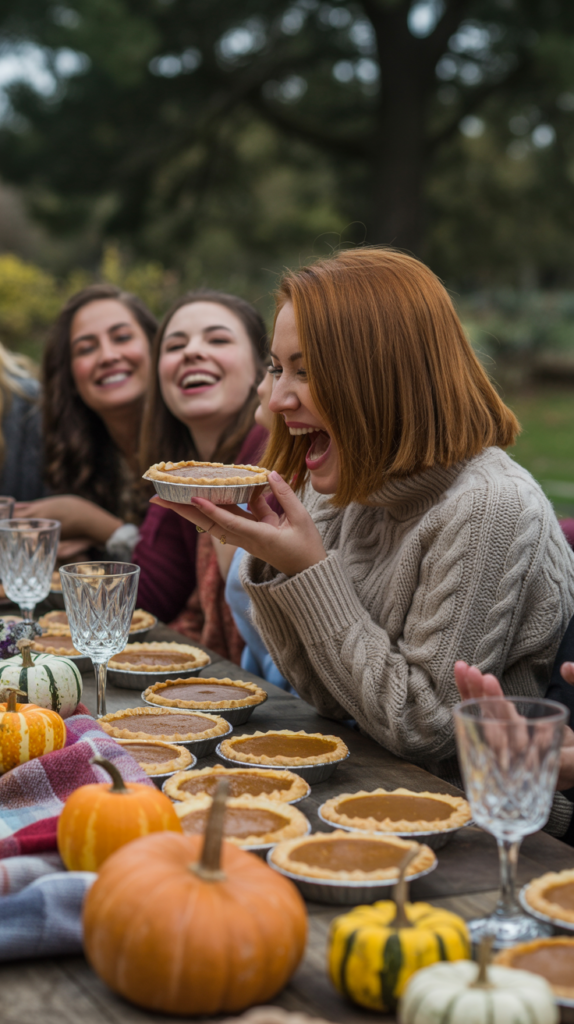
Set up a long table outside and line it with mini pies. Each teammate gets one pie, and the challenge is to finish it without using hands. The first person to clean their plate tags the next teammate to start.
The game moves quickly, and the laughter builds as everyone leans over their pies with faces covered in crumbs and filling. It’s messy, but that’s part of the fun. Friends cheer loudly as the relay continues down the line.
This game works best with small pies so no one feels overwhelmed. Keep napkins nearby and have a bucket for leftovers in case someone can’t finish. The focus stays on having fun, not on who eats the fastest.
It’s a silly, lighthearted way to break up the meal and get everyone involved. The mix of competition and laughter makes it a highlight of the night, and the photos from the relay will be worth saving.
Stuff the Turkey Sack Race
Give your Friendsgiving a playful twist with a sack race that fits the holiday theme. Use burlap sacks decorated with colorful feathers or turkey designs to set the mood. The look alone will make everyone smile before the race even starts.
Line up your friends, hand out the sacks, and watch as everyone hops toward the finish line. The wobbling and laughter make it less about winning and more about enjoying the moment.
Make the race more fun by setting up hay bales or cones as obstacles. This adds a light challenge and gives everyone a reason to cheer even harder.
Keep the course short so the game stays quick and lively. It works well for groups of any size and brings plenty of energy to your gathering.
Autumn Obstacle Course
Set up an autumn obstacle course to bring out the playful side of your Friendsgiving crowd. Use hay bales as hurdles, cones made from pumpkins, and piles of leaves to weave through. The mix of textures and colors makes the activity feel festive and fun.
Challenge your friends with a pumpkin-balancing race where each person carries a small pumpkin across the course without dropping it. The wobble of the pumpkin adds just the right amount of difficulty and laughter.
Add in a gourd stacking station where players must build a small tower before moving on. The odd shapes make it tricky, but that’s what keeps the energy high.
This game works well for guests who like friendly competition. It gets people moving, laughing, and cheering each other on, which adds a lively break between eating and chatting.
Harvest Pictionary (Outdoor Edition)
Set up a big easel or chalkboard outside so everyone has space to draw larger-than-life pictures. The open-air setting makes it easy for the whole group to gather around and watch the drawings unfold. A backyard, patio, or driveway works well for this setup.
Choose fall and Friendsgiving-themed words for the game. Ideas include pumpkin pie, hayride, apple cider, turkey, or corn maze. These seasonal prompts keep the game festive and tied to the holiday.
Encourage bold, simple sketches so even the audience can guess along quickly. Big strokes on a large board make the game more fun and easier to follow. The oversized drawings often lead to laughs, especially when the picture looks nothing like the word.
Rotate players so everyone gets a turn at the easel. Keep rounds short to maintain energy and excitement. This setup creates an easygoing way to bring people together while enjoying the crisp fall weather.
Wine Bottle Bowling
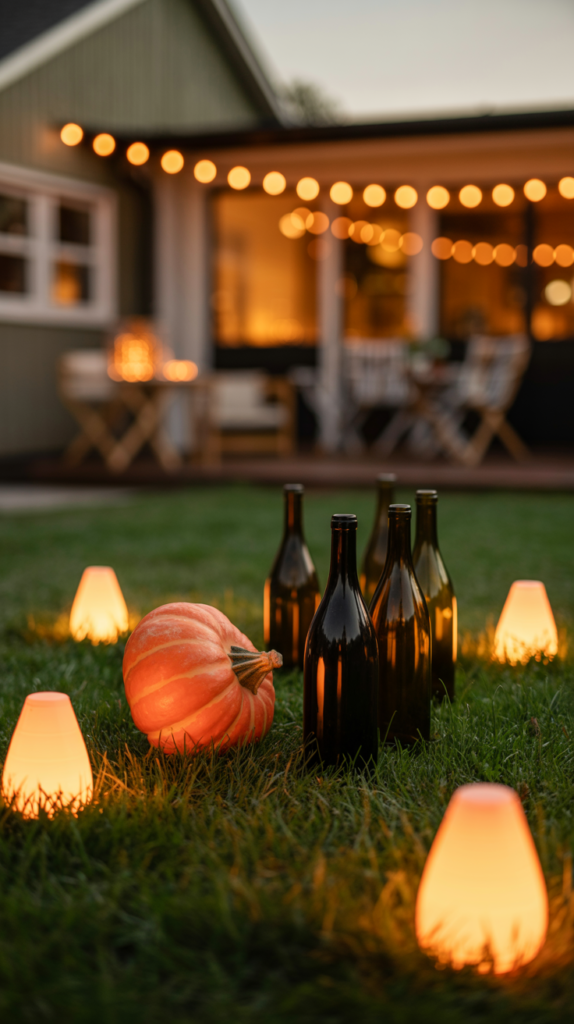
Line up a few empty wine bottles at the end of your yard or patio to act as the pins. Place them in a triangle shape, just like a real bowling setup. Use small pumpkins as the bowling balls to roll toward the bottles.
The setup takes only a few minutes and doesn’t require special supplies. It works well on grass, pavement, or even a flat indoor space if you prefer. The game feels casual and lighthearted, making it easy for everyone to join.
As the sun sets, the glow of the evening adds a relaxed atmosphere. Friends will enjoy taking turns, cheering each other on, and laughing at the unpredictable rolls of the pumpkins. It’s a simple way to bring everyone together without much effort.
Thankful Trivia Challenge
Create a trivia game that mixes holiday traditions with personal memories. Prepare questions about Thanksgiving history, Friendsgiving customs, and fun facts about your guests. This keeps the game lighthearted and personal.
Before the party, gather small details about friends, like favorite dishes, funny past stories, or quirky habits. Turn those into multiple-choice or true-or-false questions. Guests will enjoy guessing who matches each answer.
The game encourages laughter as people recall old memories and share new ones. It also sparks conversation between friends who may not know each other well. Trivia works best when everyone feels included, so keep the questions simple and fun.
Offer small prizes or bragging rights to the winning team. The focus stays on celebrating friendship and enjoying time together, not just winning. This makes the Thankful Trivia Challenge a warm addition to your Friendsgiving.
Cozy Fireside Story Swap
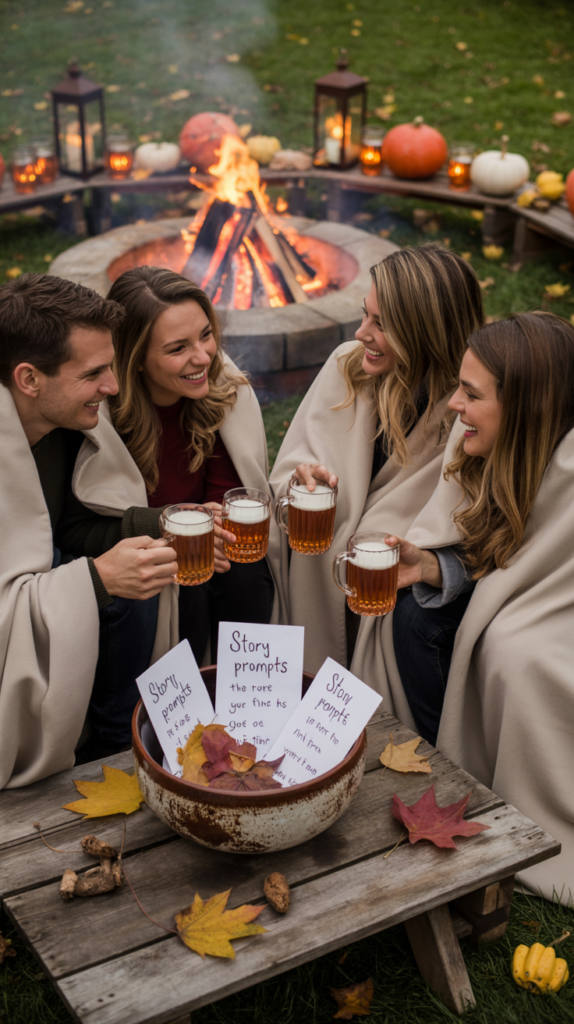
Gather your friends around a fire pit or fireplace and pass around a bowl filled with simple story prompts. Each slip might ask you to share a favorite holiday memory, a funny moment from college, or a small tradition from your family. The setting makes it feel relaxed and personal.
As each person shares, the group listens and laughs together. After a round, everyone votes on light categories like “funniest” or “most heartwarming.” The voting keeps things playful and gives each story a little spotlight.
This game works best later in the evening when everyone feels settled. With the fire glowing and stories flowing, the group ends the night in a way that feels warm and connected.
How to Choose the Right Friendsgiving Games
The best games depend on how many people are at your table, what kind of activities your friends enjoy most, and whether the group prefers lighthearted fun or a little healthy competition. Picking the right mix keeps the evening relaxed and enjoyable for everyone.
Consider Group Size and Space
The number of guests often decides which games work best. A large group may enjoy trivia, charades, or a guessing game where everyone participates at once. Smaller groups might prefer card games or board games that allow for more conversation.
Think about the space available. A small apartment may not be suited for games that require lots of movement, while a bigger living room can handle active games like relay-style challenges.
It also helps to have a mix of seated and active games. This way, guests who want to stay comfortable at the table can still join in, while others can move around if they prefer.
When planning, keep in mind how long each game takes. Short rounds keep things lively and prevent guests from losing interest.
Match Games to Guest Preferences
Every group has different personalities. Some friends enjoy silly icebreakers, while others prefer strategy or word games. Choosing games that fit your group’s style makes the night feel more personal.
Pay attention to age ranges and humor levels. A lighthearted game like “Who’s Most Likely To” may work for close friends, but a trivia game might be better if the group is mixed or includes new guests.
It helps to offer options. Have 2–3 games ready, then let the group decide what sounds fun in the moment. This keeps the energy natural and avoids forcing anyone into an activity they don’t enjoy.
Balancing Competition and Fun
Games bring out different sides of people. Some friends love competition, while others prefer a relaxed pace. Striking the right balance keeps everyone included.
Choose games that are easy to learn and don’t require long explanations. Simple rules help the group jump in quickly without stress.
Mix competitive games with cooperative ones. For example, follow a trivia round with a team-based activity. This prevents tension and keeps the mood light.
Remember that the goal is laughter and connection, not keeping score. A little competition adds excitement, but the main focus should stay on enjoying time together.
Tips for Hosting a Fun Friendsgiving Game Night
A successful Friendsgiving game night depends on creating the right atmosphere, planning activities in a clear order, and making sure everyone feels included. Small details like lighting, timing, and encouragement go a long way toward keeping the evening enjoyable for all.
Setting the Mood With Decorations
Decorations set the tone before the first game even begins. Keep things cozy with warm lighting, such as string lights or candles in safe holders. Add seasonal colors like orange, brown, and gold to tie in the Friendsgiving theme.
A simple table setup goes a long way. Place small pumpkins, leaves, or handwritten name cards at each spot. These details make the space feel welcoming without overwhelming guests.
Think about comfort as well. Arrange enough chairs and pillows so people can gather easily for group games. A relaxed setting helps guests focus on having fun rather than worrying about where to sit.
Creating a Game Schedule
A loose schedule helps the night flow smoothly. Start with easy icebreakers while everyone settles in. These short games break the silence and get people laughing right away.
After dinner, move into group games that keep energy high. Trivia, bingo, or charades work well when everyone is ready to join in. Save more competitive or active games for later in the evening when the group feels comfortable.
Keep flexibility in mind. Not every game needs to run long. If a game loses steam, switch to the next one. Having a list of backup ideas ensures no one feels stuck waiting for the fun to return.
Encouraging Participation
Not every guest will jump into games right away, so gentle encouragement matters. Pair quieter friends with outgoing ones during team activities to balance comfort levels.
Offer options so people can choose what suits them best. Some may prefer quick card games, while others like group challenges. Variety makes it easier for everyone to find something enjoyable.
Positive energy from the host sets the tone. Smile, explain rules clearly, and keep the focus on fun rather than competition. When guests feel included and relaxed, they are more likely to join every round.

